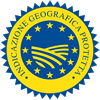Description
Salame Felino PGI is a raw and cured charcuterie product, obtained from the processing of fresh meat from pigs belonging to the Large White and Italian Landrace breeds, and other breeds compatible with the Italian heavy pig or offspring of the Duroc breed.
Production Area
The production area of Salame Felino PGI is within all the municipalities in the Province of Parma, in the Emilia-Romagna region.
Production Method
The selected meat cuts are made up of muscular and fatty parts; underbelly and/or picnic shoulder. After they have been carefully cleaned and trimmed, the cuts are refrigerated at a temperature of no less than -1°C. They are then minced in a mincer that has holes with a diameter of 6-8 mm. The minced product is mixed with salt, pepper corns and/or crushed pepper, crushed garlic, wine and sugar, after which it is inserted into natural pig casings and tied with string. During the drying process, the salami is left in special rooms, at a temperature between 13 e 24°C; the process lasts for 4-6 days, so as to ensure that it is thoroughly dehydrated. Curing takes place in environments with sufficient exchange of air, at a temperature of between 12 and 18°C, and must last for at least 25 days. Due to the delicacy of the product, which is rich in unsaturated fatty acids and low in preservatives, the potentially critical cutting and packaging stages must be carried out by qualified personnel within the production area.
Appearance and Flavour
Salame Felino PGI has a cylindrical shape, with one end larger than the other. The consistency is compact, but not springy, and it weighs between 200 g and 4.5 kg. Its external surface is whitish-grey in colour, slightly powdery due to the development of a moderate amount of indigenous moulds. On cutting, the slice is ruby-red, uniform and lean. It has a sweet and delicate taste.
History
The first references to salami being produced in the typical area can be found in De re coquinaria (1st century AD), written by Marcus Gavius Apicius. It seems as is if the most ancient depiction of the product is found in the decoration inside the Baptistery in Parma. There is evidence of a particular method of transforming pork into salami being used in the Municipality of Felino in the 1800’s, and in 1905 the term Salume Felino appears in the Italian dictionary for the first time. Local public institutions have recognised the “Salame Felino” designation in regard to salami produced in the Province of Parma since 1927, as the its use was a way to promote the Province’s affluence. The local authorities still organise events and exhibitions in Italy and abroad today, with tastings and information stands. As testimony to the relationship between this unique product and its terroir of origin, there is the Museum of Salame Felino in the cellars of Felino Castle.
Gastronomy
Salame Felino PGI should be kept in a cool dry place, or in the least cold compartment of the refrigerator. It is considered starter par excellence in the typical Parma cuisine. It is best served in slices with a thickness of about 5 mm, which traditionally should be “the shape of a clarinet beak”, that is, sliced diagonally. It should be served with micca, typical Parma bread, and Parmigiano Reggiano PDO, and paired with a sparkling Colli di Parma PDO Malvasia.
Marketing
Salame Felino PGI is sold year-round, whole, in pieces and sliced, vacuum- packed or in modified atmosphere packaging.
Distinctive Features
The production area of Salame Felino PGI is distinguished by its hilly and lowland areas, as well as the presence of lakes and mineral salts. Thanks to the latter, since the thirteenth century the salting and processing of pig meat has led to the creation of products which are recognised both nationally and internationally.
















